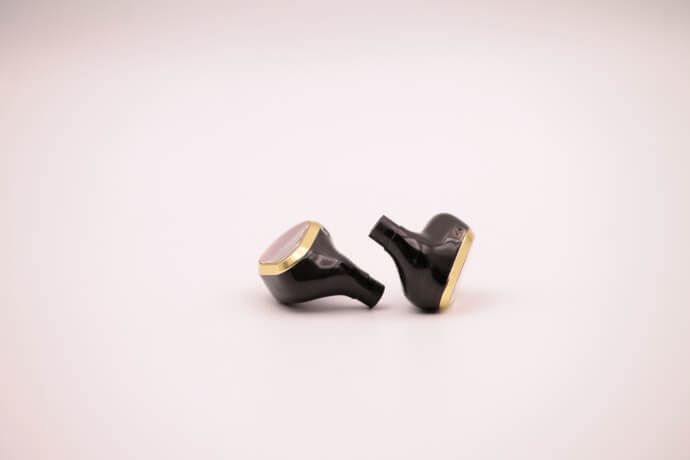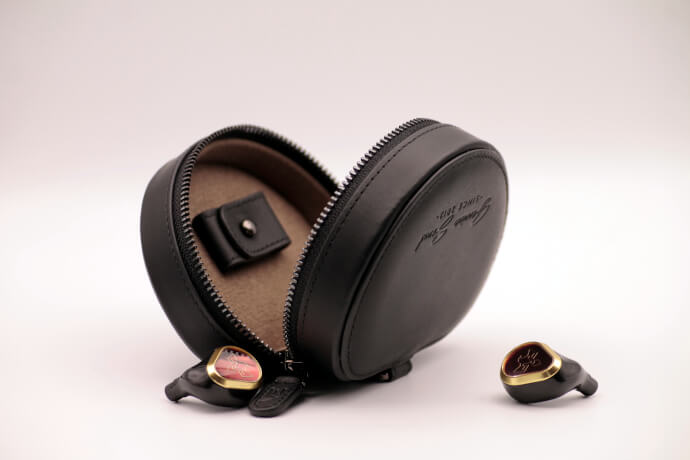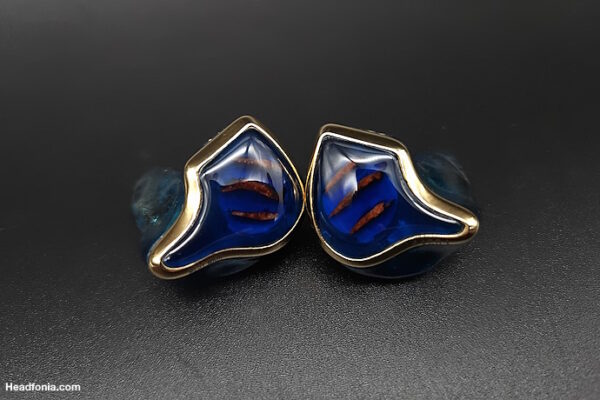Build Quality
The biggest complaint I saw for the Erlkönig was its weight. Since it was made out of pure silver shells, it had quite a bit around its waist. Vision Ears listened and made the shells for the Phönix out of carbon fibre, which is a lot lighter, but still very strong. The shells are in all-black carbon, so there’s no colour mix in there. To me that’s good, I like things simple and elegant.
On top of the black carbon fibre shells, the Phönix comes with a shiny red mirror face-plate and a golden ring around it. Black, Red and Gold. Remind you of something? The German flag features the same three colours. If that’s a coincidence or not is up for VE to clarify. Nevertheless I think the Phönix is one of the nicest to look at IEMs that I ever came across.
For those that don’t want a golden ring around the face-plate, there’s also the option to go matte-black. I haven’t seen that one (yet), but I am sure it’s just as beautiful as mine. On the red mirror face-plate you’ll spot the Phönix logo in gold. If you’ve ever seen the Erlkönig’s logo, you’ll notice that it is an evolution of sorts of it.
The mirror face-plate is a real fingerprint magnet. If you like your IEMs to be all clean (like me), you’ll have to wipe them off every time after you use them.
Alright, from a visual standpoint the Phönix is a winner (to me). But we haven’t talked about the general build quality yet. So let us take a look at that.

The Phönix features industry standard .78mm two-pin connectors. These stand out just a tiny bit from the shells on mine, so they are not 100% flush, which is nothing concerning, but still might be my only point of critique when it comes to the build quality.
Apart from that very minor flaw, the Phönix is made to perfection. What actually surprised me a little was the form and size of the shells in total. Remember, there’s 13 (thirteen!) balanced armature drivers in them. For that the Phönix is actually quite small in size.
They sit firmly and snug in my ears and they isolate very well. In the recent weeks I have been using other IEMs that isolate a whole lot less than the Phönix, and going to the VE made me realise again how important good isolation is to me. The better the isolation, the lower I can go with volume, the more I protect my hearing.
Now I know, many people want a custom made Phönix from VE, since they manufacture CIEMs too. But unfortunately the internal structure of the Phönix doesn’t allow it. So don’t hold your breath for that to happen. Under the hood of the Phönix are quite a few out-of-the-box solutions that won’t allow to be replicated in a custom shell.
Sound
VE gives a bit of information on the sound of the Phönix on their website.
Here’s what they say about it:
The lows are well controlled, with a striking and intensive impact. The depth and sub-bass feeling is almost of a dynamic driver, giving the overall sound a stunning, beautifully layered and solid ground. Vision Ears is widely known to give great attention to the mid presentation, with the PHöNIX we created a charismatic and staggering mid-range, full of vivid details and an unparalleled naturalness. The richness of details is breathtakingly uncompromising. The highs are unfolding with a natural timbre, slightly sparkling and at all time not exaggerating. The all new Super-Tweeter of the PHöNIX is giving extra airiness to the sound. Unveiling the barely perceptible with ease and refining the highs with a stunning openness.
Quite a bold statement to make, right? Let’s see if their words hold up to it.
The Phönix has a very pleasing and natural sound, that has it’s main focus on, for the lack of a better word, musicality. You in fact do get the traditional VE mids, with excellent layering and emotions. It features very well extended highs with a pretty linear curve up there, but doesn’t have the deepest extension in the lows. Let’s dive deeper (pun intended).
Phönix’ bass is well controlled indeed, it has beautiful body, weight and presence. Bass guitars sound realistic and with good dynamics to them. Lower key instruments in general have good density and structure to them. Instruments that go deep down have a life-like sound to them with good resolution and texture.
The bass has a definite attention to mid and upper bass, where sub-bass is not as much in focus and has a distinct roll-off. People who want a lot of pump and thunder probably won’t be satisfied. But anyone who’s after an organic and natural lower end, is likely to find pleasure in the Phönix. The Phönix’ bass is well executed when looking at resolution, texture and layering, but to me, there still is room for improvement. They unquestionably sound like balanced armatures, which they are. But in all honesty, I think a dynamic driver would probably mess up the entire presentation of the Phönix as a whole.

The transition from bass to mids is about as seamless as it can possibly be. Some manufacturers have problems with this part, where the upper bass overshadows the lower mids and then masks up some of the mid-range clarity needed. The Phönix perfectly and smoothly surpasses this critical area and gives you a nicely open, yet well formed and soft mid-range.
Deep vocals have good body and substance to it. One thing that I like about the Phönix in particular is how well it manages to capture minute details in the mids. How well it places and reproduces voices and instruments. This is without a doubt the traditional VE mid-range. And it is abundantly clear how much attention of their tuning goes into it.
The upper mids are a real treasure to me. There’s this certain glow in them, that gives bells or wind instruments a touch of softness, that makes them just oh so great. I really don’t know how else to describe them, other than they are perfect. The upper mids aren’t too forward or too thin sounding, so the Phönix will in no way sound shouty if you’re afraid of that kind of tuning.
The mids have a slight warmth in them, to give them a pleasant sound, a sound that’s easy to fall in love with. And that is exactly what it does, or did to me at least. The Phönix features a rich and soulful tuning that goes very well with most genres. To me it’s best suited with acoustic music. Music that lets you sink in and kick back. But the Phönix also masters heavy guitar riffs and very complex classical arrangements. When listening to electronic music or hip hop the Phönix left me wanting more sub-bass and more authority in the lows.
Treble extends wide and with good presence into the five-digit frequencies. The highs have the same soft glow as the upper mids that I was talking about before. This makes them again easy to listen to and keeps you safe from piercing treble that might potentially hurt your ears and hearing. The Phönix has an airy and open sounding top end. The treble pushes good air and detail into the sound and its presence helps keep a very good balance.
The Phönix has its forte in its technical abilities. It has high resolution and one of the nicest imaging capabilities I have heard to date from an In Ear. The Phönix places musicians with pin-point precision on stage and gives you a nicely dark and solid background. Even though its very high sensitivity it doesn’t show any hiss on any of my sources. The room Phönix creates has impressive dimensions, it stretches deep and wide, where you’re placed in a front row seat watching the performance.
All in all I don’t fully agree with how VE describes the Phönix on their website, but it’s a spectacular sounding monitor nonetheless. One that manages to pull me back into the sofa and lets me enjoy my favourite albums from cover to cover.
Now, for fun I hooked up the Phönix to my two-channel system – straight into the Hugo TT2. Holy smokes that thing scales! The extra level of details, texture, layering and width/depth is simply amazing.
Back to page one for general info and Package
Jump to page three for Comparisons and Final Verdict







